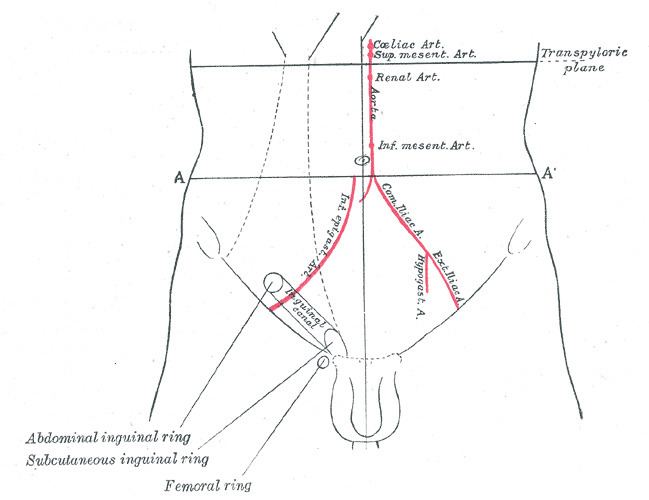Latin canalis inguinalis TA A04.5.01.026 | MeSH A01.047.412 FMA 19928 | |
 | ||
The inguinal canals are the two passages in the anterior abdominal wall which in men convey the spermatic cords and in women the round ligament of uterus. The inguinal canals are larger and more prominent in men. There is one inguinal canal on each side of the midline.
Contents
Structure
The inguinal canals are situated just above the medial half of the inguinal ligament. In both sexes the canals transmit the ilioinguinal nerves. The canals are approximately 3.75 to 4 cm long., angled anteroinferiorly and medially.
A first-order approximation is to visualize each canal as a cylinder.
Walls
To help define the boundaries, these canals are often further approximated as boxes with six sides. Not including the two rings, the remaining four sides are usually called the "anterior wall", "inferior wall", "superior wall ("roof")", and "posterior wall ("floor")". These consist of the following:
Development
During development each gonad (ovary or testicle) descend from their starting point on the posterior abdominal wall (para-aortically) from the labioscrotal swellings near the kidneys, down the abdomen, and through the inguinal canals to reach the scrotum. Each testicle then descends through the abdominal wall into the scrotum, behind the processus vaginalis (which later obliterates). Thus lymphatic spread from a testicular tumour is to the para-aortic nodes first, and not the inguinal nodes.
Function
The structures which pass through the canals differ between males and females:
The classic description of the contents of the spermatic cords in the male are:
3 arteries: artery to vas deferens (or ductus deferens), testicular artery, cremasteric artery;
3 fascial layers: external spermatic, cremasteric, and internal spermatic fascia;
3 other structures: pampiniform plexus, vas deferens (ductus deferens), testicular lymphatics;
3 nerves: genital branch of the genitofemoral nerve (L1/2), sympathetic and visceral afferent fibres, ilioinguinal nerve (N.B. outside spermatic cord but travels next to it)
Note that the ilioinguinal nerve passes through the superficial ring to descend into the scrotum, but does not formally run through the canal.
Clinical significance
Abdominal contents (potentially including intestine) can be abnormally displaced from the abdominal cavity. Where these contents exit through the inguinal canal the condition is known as an indirect or oblique inguinal hernia. This can also cause infertility. This condition is far more common in men than in women, owing to the inguinal canal's small size in women.
A hernia that exits the abdominal cavity directly through the deep layers of the abdominal wall, thereby bypassing the inguinal canal, is known as a direct inguinal hernia.
